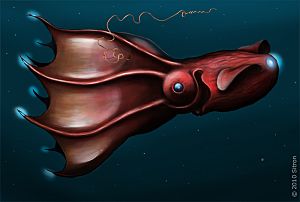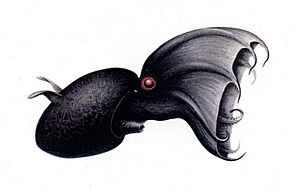Vampire squid facts for kids
Quick facts for kids Vampire squid |
|
|---|---|
 |
|
| Adult vampire squid illustration | |
| Scientific classification | |
| Genus: |
Vampyroteuthis
|
| Species: |
infernalis
|
| Synonyms | |
|
|
The Vampire squid (Vampyroteuthis infernalis) is a small animal that lives deep in the ocean. Its scientific name means 'vampire squid from hell'. But don't worry, it's not scary! It's a type of cephalopod, which is a group of sea animals that includes squid and octopus.
You can find the Vampire squid in deep parts of the world's temperate and tropical oceans. It has special filaments that it can pull back into its body. Because of these unique features, it belongs to its own special group called Vampyromorphida. It is the only living member of this group. Scientists first described it in 1903, but they thought it was an octopus back then.
Contents
What Does a Vampire Squid Look Like?
The Vampire squid can grow to about 30 centimeters (1 foot) long. It is completely harmless to humans. Its body is soft and jelly-like, about 15 centimeters (6 inches) long. Its color can be very dark, like velvet black, or a pale reddish, depending on where it lives and the light.
It has eight arms connected by a web of skin, which looks like a cape. This "cloak" is black on the inside. Each arm has rows of soft spines called cirri. Only the ends of its arms have suckers. Its large, clear eyes can look red or blue, also depending on the light. These eyes are about 2.5 centimeters (1 inch) wide. They are the biggest eyes for its body size in the whole animal kingdom!
Fins and Filaments
Adult Vampire squid have two ear-like fins on the sides of their mantle. These fins help them move through the water. They "fly" by flapping their fins. Their strong, beak-like jaws are white, like ivory.
Inside the webbed arms, there are two hidden pouches. These pouches hold special velar filaments. These filaments are like the long tentacles that true squid have. However, they are a different pair of arms. They are actually the same pair of arms that ancestral octopuses lost a long time ago.
Light-Up Body
The Vampire squid is covered in organs that make light, called photophores. It can control these organs very well. It can make flashes of light that last from a fraction of a second to several minutes. The brightness and size of these lights can also change.
These photophores look like small white discs. They are bigger and more complex at the tips of the arms and near the fins. The underside of its webbed arms does not have these lights. Two larger white areas on its head were once thought to be light-makers, but they are actually photoreceptors, which help it detect light.
Unlike many other cephalopods, the Vampire squid cannot change its skin color much. This is because its chromatophores (pigment organs) are not well developed. But it doesn't need to change color in the deep, dark ocean where it lives.
Where Do Vampire Squid Live?
The Vampire squid is a great example of an animal that lives in the deep sea. Scientists believe it lives in dark areas from 600 to 900 meters (2,000 to 3,000 feet) deep, or even deeper. This part of the ocean is called the oxygen minimum zone (OMZ). In the OMZ, there is very little oxygen. Most animals cannot live there.
However, the Vampire squid can live normally in the OMZ, even with oxygen levels as low as 3%. This is something almost no other animal can do!
How Do They Survive in the Deep Sea?
To live in this tough environment, Vampire squid have developed amazing adaptations:
- They have the lowest metabolic rate of all deep-sea cephalopods. This means they use very little energy.
- Their blue blood contains hemocyanin, which is very good at picking up and carrying oxygen.
- They have large gills to help them get oxygen from the water.
- Their muscles are weak, but they can move easily because their body tissues are jelly-like and full of ammonium. This makes them float easily in the water.
- They have special balancing organs called statocysts, which are like our inner ears.
Avoiding Predators
In the shallower parts of the Vampire squid's home, the view from below looks like twilight. Deep-sea animals have very sensitive eyes and can see the shadows of other animals above them. To hide, the Vampire squid makes its own bluish light. This is called bioluminescence. It uses this light to blend in with the faint light from above, making it hard for predators to see its shape. This trick is called counterillumination.
Vampire squid also have large eyes that can spot even the smallest glimmers of light. They have two light-detecting organs on top of their heads, which might warn them about movements above.
Unlike most other cephalopods, Vampire squid do not have ink sacs. If they feel threatened, they shoot out a sticky cloud of glowing mucus from their arm tips. This cloud is full of tiny blue lights. This bright display can last for almost 10 minutes. It probably confuses predators, allowing the Vampire squid to escape into the darkness without having to swim far. They only do this if they are very scared.
Life Cycle and Reproduction
The Vampire squid goes through three different body shapes as it grows. Young squid have one pair of fins. Then, they grow two pairs of fins. Finally, as adults, they have only one pair again. As they grow, their fins change size and position to help them swim best. Young squid mostly move by jet propulsion, but adults flap their fins. This unique growth pattern confused scientists in the past, who thought the different forms were separate species.
Vampire squid likely reproduce slowly, laying a small number of large eggs. Food is scarce in the deep ocean, so they grow slowly. Finding a mate in their vast habitat is rare. A female can store a male's spermatophore (a packet of sperm) for a long time before she is ready to fertilize her eggs.
Once she fertilizes her eggs, she might need to care for them for up to 400 days before they hatch. During this time, the female does not eat. She dies soon after her eggs hatch.
Hatchlings
Baby Vampire squid, called hatchlings, are about 8 millimeters long. They look like tiny versions of the adults, but with some differences. Their arms don't have webbing, their eyes are smaller, and their velar filaments are not fully formed.
Hatchlings are transparent and live off a large internal yolk for a while before they start to eat on their own. The smaller squid live in even deeper waters, possibly eating "marine snow" (bits of dead plants and animals that fall from the surface).
Behavior of the Vampire Squid
Most of what we know about Vampire squid behavior comes from short observations by ROVs (remotely operated vehicles). When captured, these animals are often hurt and usually live for only about two months in aquariums. It's hard to study their normal behavior in an artificial environment.
Scientists have seen Vampire squid drifting in the deep ocean currents with their long velar filaments spread out. If something touches the filaments, or if they feel vibrations, the squid quickly investigate with acrobatic moves. They can swim very fast, up to two body lengths per second, and can speed up in five seconds. However, their weak muscles mean they get tired quickly.
Saving Energy
Unlike their relatives in shallower waters, deep-sea cephalopods cannot afford to waste energy by swimming away for a long time. Because they have a low metabolic rate and food is scarce, Vampire squid must use clever ways to avoid predators and save energy.
Their glowing "fireworks" display, combined with wiggling glowing arms, sudden movements, and quick escapes, makes it hard for a predator to catch them.
Defense Mode
When threatened, the Vampire squid uses a defense called the "pumpkin" or "pineapple posture." It pulls its webbed arms back over its body. This makes it look bigger and shows off its harmless but scary-looking spines (cirri). The underside of the cape is very dark, hiding most of its light-producing organs. The glowing arm tips are grouped together far above its head, drawing attacks away from its important body parts. If a predator bites off an arm tip, the Vampire squid can grow it back!
What Do They Eat?
Scientists have reported that Vampire squid eat Copepods (tiny crustaceans), prawns, and cnidarians (like jellyfish). Not much else is known about their eating habits. Given their environment, they probably aren't very picky about what they eat.
Vampire squid have been found in the stomachs of large deepwater fish, deep-diving whales, and pinnipeds like sea lions.
Vampire Squid Family Tree
The Vampyromorphida group, which includes the Vampire squid, has special features. They have light-producing organs, a unique unhardened internal shell called a "gladius," eight webbed arms, and two velar filaments.
For a long time, scientists only knew about the modern Vampire squid and a few old fossils that might have belonged to this group. But then, some fossils found in France, from about 165-164 million years ago (in the Middle Jurassic period), showed clear signs of vampyromorphid cephalopods. These fossils were named Vampyronassa rhodanica. This proved that these animals have been around for much longer than previously thought.
Some other supposed vampyromorphid fossils from the Solnhofen Limestone (156-146 million years ago), like Plesioteuthis prisca, Leptoteuthis gigas, and Trachyteutis hastiformis, are large species. They have features that are not found in vampyromorphids. Instead, they are more similar to true squids, called Teuthida.
Images for kids
-
A pyritized fossil of Vampyronassa rhodanica from La Voulte-sur-Rhône.
See also
 In Spanish: Calamar vampiro para niños
In Spanish: Calamar vampiro para niños





